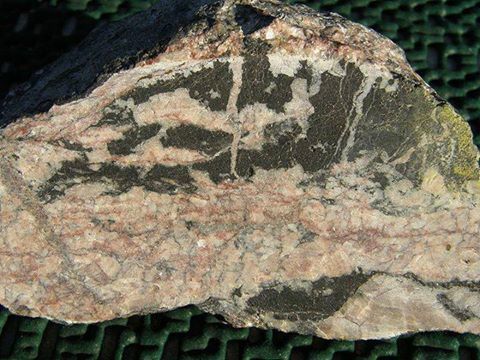How to build a nuclear plantYou’re looking at a sample of the mineral “pitchblende”. It also goes by
How to build a nuclear plantYou’re looking at a sample of the mineral “pitchblende”. It also goes by another name, “uraninite”. This mineral and the elements that make it up are the key elements in allowing humanity to unleash the power of the atom. This week, another of the negative outcomes of that power has been back in the news; the Fukushima Daiichi nuclear power plant in Japan, which melted down following the 2011 Tohoku great earthquake.From an Earth Story perspective, I think the Fukushima disaster is a fascinating look at a lot of different types of science, including nuclear chemistry and environmental degredation. So, I’ve prepared a series of posts on how a nuclear reactor operates normally and what happened specifically at Fukushima through today. Here’s the first, hope you find it informative.Uranium, mined from this mineral, is the key element in controlled nuclear fission. It has 2 isotopes, one with mass 235 and another with mass 238. They differ in the amount of neutrons in the nucleus.Neither of these isotopes is stable, both of them undergo radioactive decay, but they take billions of years to decay away fully so they’re still around. But there is one other thing they do…fission.Uranium 238 will spontaneously split into 2 elements, usually with masses around 100 and 135. When this isotope undergoes fission, it also releases several high-energy neutrons. It does this naturally with no outside input.Uranium 235 does not spontaneously undergo fission, it only decays by losing an alpha particle (basically it shoots off helium). But, if uranium 235 is hit by a high-energy neutron, it will undergo induced fission; hitting it with a neutron causes decay.A mix of these 2 isotopes does something really interesting. When a U-238 decays, it releases neutrons. If one of those neutrons hits a U-235, it causes that atom to fission, giving off more neutrons. Those neutrons can hit other atoms of U-235, causing a chain reaction; the neutron given off by one decay starts the next decay.That sequence means…the more U-235 in a mixture, the more fission results. However, most of the U-235 in this solar system has already decayed away. Today, only 0.72% of natural uranium is U-235; that’s not enough to continue a chain reaction. Using isotope enrichment techniques such as centrifuges, those amounts can be increased to 10-20%, which are high enough to allow for chain reactions.The more enriched the sample is in U-235, the more energy will be released, because a single fission reaction releases large amounts of energy. For applications in power plants, the more decays there are, the hotter the sample gets, and the more efficient power generation becomes. (I’m leaving plutonium out of this discussion but it can fill the same role).But there’s a problem…the sample can get too hot. To produce a nuclear power plant, there needs to be some control, some way of slowing down or moderating the reaction. To do that requires some material that can absorb or slow down neutrons; take away some of the neutrons and the reaction rate slows down.There are several materials that can work, but in theory, water is about as perfect of a material as you can find. When a neutron impacts a hydrogen atom, like those found in water, it can either bounce off and be slowed down or react with the atom to form deuterium. Placing uranium in water should allow for a stable reaction. If the reaction gets too hot, add more water; too cold, remove some water. And for power generation it works great, because hot water is what is used to power steam engines for electricity generation anyway! Other elements, such as carbon, have been used in previous versions as well, but a modern “light-water reactor” uses…light water, able to take up those extra neutrons.Of course, there are a few downsides. First, the products of fission reactions are also radioactive themselves; some of the common ones are strontium, cesium, barium, and yttrium, and they all have too many neutrons because they’re created by a heavy uranium atom. Those elements can dissolve in the water, turning the water into nuclear waste.The other potential problems come from balancing the reactor. Every nuclear power plant accident in history has in some way involved an imbalance between the heating and the material used for control. If not enough neutrons get absorbed, the nuclear material can heat up very quickly, and the combination of overheated material and water can lead to rapid boiling and explosions. In the next article, I’ll apply these details to the Fukushima Daiichi plant itself.JBBImage credit:http://commons.wikimedia.org/wiki/File:Pitchblende371.JPGOther details:http://www.globalsecurity.org/wmd/intro/u-isotopes.htmhttp://hyperphysics.phy-astr.gsu.edu/hbase/NucEne/fisfrag.html -- source link
Tumblr Blog : the-earth-story.com
#nuclear reactor#science#geology#uranium#pitchblende#nature#nuclear waste#pollution#neutron#physics#fission#energy#power plant#radioactive#plutonium
